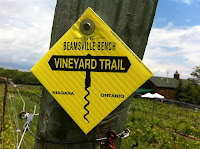Our final winery visit in Napa Valley was to Joseph Phelps Vineyards, which makes some of the best wines in the world. The winery, however, does not offer tours and tastings are by appointment only. The entrance and reception was the most businesslike and least friendly of the wineries we visited (see Mondavi and Montelena) as if they are doing you a favour by letting you visit. Of the two tasting packages available, we chose to sample 6 wines for $30 dollars each. Although that may seem very expensive, you would have to spend $450 to buy those 6 bottles so it wasn't unreasonable to pay $30 to taste these wines.
Reception gave us each a glass, then escorted us out to the patio, surrounded by beautiful vistas of vineyards. The serving staff were much friendlier and clearly very proud of their winery and its wines. The servers had a very standard pour, though, of about 1.25 oz; no amount of schmoozing would get you extra wine here. Actually, since any purchases are made back at reception on the way out, the servers aren't that connected to the sales function. I suppose they expect (rightfully so) that the wine will sell itself.
Below are the highlights of our flight of 6 wines. Each wine was far more complex than these notes indicate.
2012 Sauvignon Blanc, St. Helena, $35 - chemical nose, flowery palate, fuller bodied than most I've tried.
2011 Chardonnay, Freestone Vineyards, $55 - loved it, better than Montelena, brought 1 bottle home.
2011 Pinot Noir, Freestone Vineyards, $55 - bright red colour, nose of sweet red cherry / pie filling and orange peel, fantastic balance of acidity and tannin, spicy and juicy with a strong finish.
2010 Cabernet Sauvignon, Napa Valley, $65 - rated 94 by Robert Parker's Wine Advocate, but needs another 10 years to soften the tannins. Beautiful mid-palate flavour. Brad loved it, Chris didn't, Brad drank Chris' glass!
2009 Insignia, $200 - Phelps' signature wine, this vintage rated 95 by Robert Parker's Wine Advocate. Tar, spice, sweet red apples. Better than the cabernet sauvignon, but $135 better?
2011 Eisrebe, $50 - California's answer to icewine is to put the late harvest Scheurebe grapes in a freezer. Honey, apricot, peach, orange blossom, a hint of caramel and brilliant acidity.
At checkout, we needed to purchase some extra wine-skins (wine bottle fitted bubble wrap for travelling) to keep the bottles we'd bought safe in our luggage on the plane. Much to our delight, Joseph Phelps sells resealable wine-skins, which we'd never seen before. The ones we usually buy are single use, but can usually be pushed to 2 or 3 uses. We stocked up on these, knowing we'll never have to buy them again, and comforted by the fact that YOU CAN PUT NEW WINE INTO OLD WINE-SKINS AFTER-ALL!


























.JPG)
.JPG)










.JPG)










